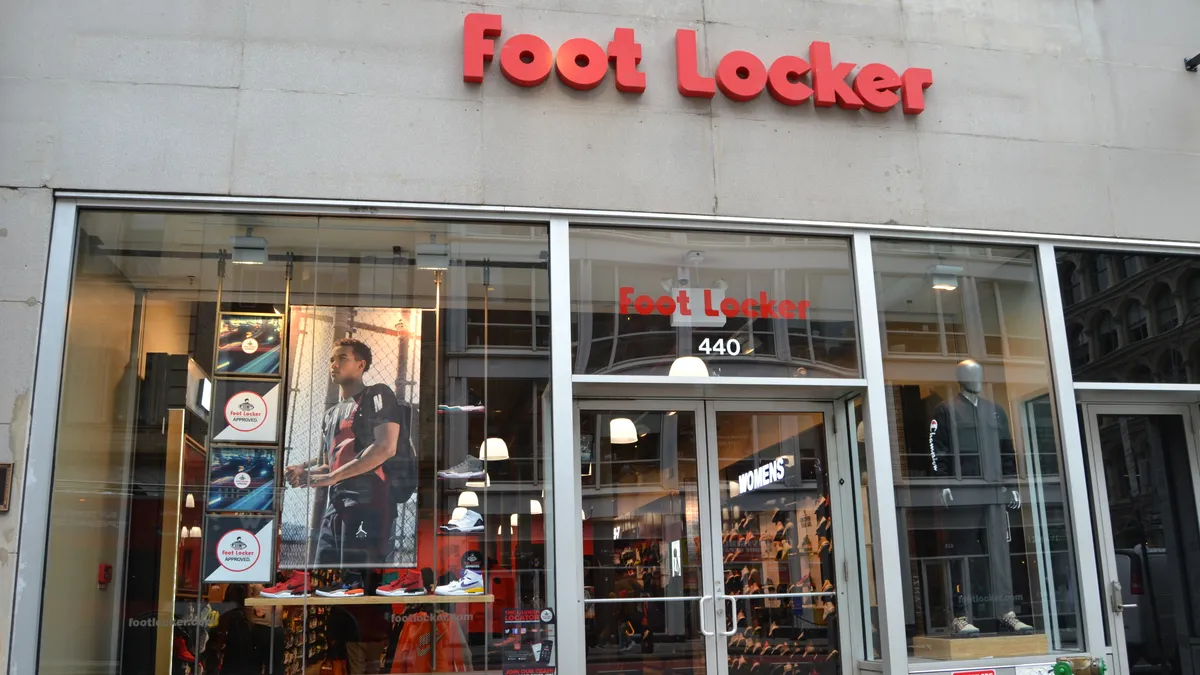Dive Brief:
- Foot Locker expects its amount of Nike product to "decline meaningfully" as Nike accelerates its DTC strategy. Nike is Foot Locker's largest supplier.
- Foot Locker CEO Dick Johnson said on a call with analysts that the company will maintain a "strong relationship" with Nike and the brand will remain an important partner, especially in categories like basketball.
- For the upcoming fiscal year, Nike is expected to make up 60% of Foot Locker's total purchases, which is down from 75% in 2020 and 70% in 2021. Foot Locker attributed the shift to Nike's "accelerated strategic shift to DTC" and Foot Locker's own diversification efforts.
Dive Insight:
Foot Locker has been one of a few key wholesale partners that Nike names in its own earnings results, and so far has been protected from Nike's shift out of undifferentiated wholesale. Now, however, the relationship between the two companies is changing.
For 2022, Nike will make up 60% of Foot Locker's supplier spend, but come Q4, Foot Locker expects Nike to make up no more than 55% going forward. While some of that is undoubtedly because of Nike's shift to a more DTC model, Johnson also said the decision is for Foot Locker's health as a business. Foot Locker had a heavy concentration of certain popular Nike products in 2020 and 2021, which drove great results but goes against Foot Locker's aim of being a "house of brands."
In 2020, some of the high Nike concentration was based on "the thought of survival," Johnson said. As the impact of the pandemic has waned, however, the retailer can return to its strategy of diversifying its offerings. Non-Nike comps at Foot Locker grew by over 30%, according to Johnson, though its non-Nike brand partners are "a little bit less productive" than Nike.
"There's nothing like a retro Jordan launch that comes in on a Friday and sells on a Saturday," Johnson said.
Foot Locker's 2021 performance
| Metric | 2021 | Year-over-year growth |
|---|---|---|
| Net sales | $8.96 billion | 18.7% |
| Net income | $892 million | 176% |
| Operating income | $860 million | 184% |
Source: Foot Locker press release
Foot Locker will still have access to Nike's top products, but the amount it receives will change. Johnson also emphasized that part of Nike's success comes from its ability to control the scarcity of its products. By limiting the amount of products Foot Locker receives, Nike might drive more sales of hot products through its own channels, but executives still expect Foot Locker to benefit as well.
In response to the decrease in Nike products, Foot Locker is ramping up the contribution from other suppliers, including a recent deal with Reebok to gain exclusive access to some of its products, and continuing to build out its private label assortment.
Despite the loss of Nike, "Foot Locker's strategic shift to add more brands and be less dependent on one vendor, transition its store base to off-mall locations, and participate in new revenue streams like resale with GOAT make sense and should strengthen the company's position in the marketplace [and] add shareholder value over time," Telsey analysts, led by Cristina Fernández, wrote in emailed comments.
The move is already impacting Foot Locker to a serious degree, though, and some analysts are not as convinced about what Foot Locker's future looks like without Nike. Wedbush analysts Tom Nikic and Ezra Weener wrote in emailed comments that they "don't really see a silver lining here."
"Being a 'strategic partner' doesn't mean as much as it used to. For years, the bear thesis on [Foot Locker] was predicated on [Nike] de-emphasizing them due to their own DTC ambitions, but [Foot Locker] had continued to grow with Nike due to its position as a 'strategic partner,'" they said. "But that all seems to be changing now. … As a result, [Foot Locker] gave extremely disappointing guidance for FY22: Comps down 8-10%, gross margin down more than 400bps and EPS down 40-45% to $4.25-$4.60."
Foot Locker's guidance for 2022
| Metric | Expectation for 2022 |
|---|---|
| Net sales | -4% to -6% |
| Comp sales | -8% to -10% |
| Gross margin | 30.1% to 30.3% |
| Earnings per share | $4.25 to $4.60 |
Source: Foot Locker press release
While Foot Locker's executives were clear that the move would negatively impact its business, they were also certain that shifting away from so much reliance on one partner was necessary given the consumer's desire for uniqueness and choice.
"When 75% of your purchases are from one vendor, it doesn't leave a lot of room for choice," Johnson said.













